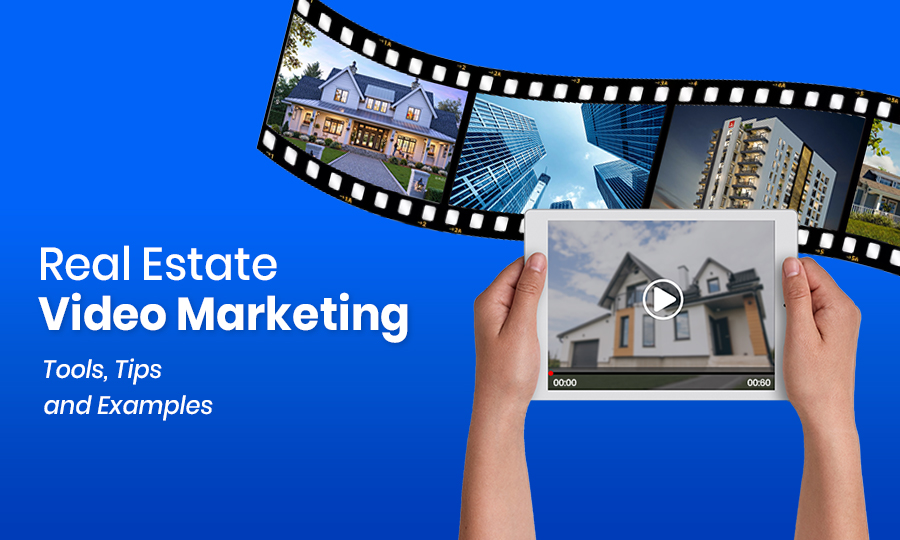In this fast-paced world, visuals are the most influential in the communication process. Video marketing for real estate professionals is the most effective way to get new clients. Yes, you may rely on traditional marketing like spreading flyers and placing hoardings of your brand. But you need an online presence to grab the whole market share. People prefer watching videos over reading lengthy texts in the current digital era. The National Association of Realtors (NAR) reports that Each week, 80% of consumers watch online videos, and nearly half of them say a video has influenced their purchase decision.
Though there are dozens of online marketing strategies available social media ads, email campaigns, SEO(Search Engine Optimisation), Pay-Per-Click Ads(PPC), content marketing, collaborate with influencers, and more video marketing stands out as the most effective for realtors. In contrast to other digital marketing approaches that depend on text or still images, video can connect with the audience’s mind and build an emotional connection. Videos are processed by the brain 60,000 times faster than text, making them more engaging.
Video marketing for real estate professionals consists of various strategies, like you have to maintaining the quality of your video content, and designing a story to portray your luxurious properties. So, in this guide, you will discover which kind of videos are the best for the real estate business and what the most useful tools are to edit videos, and which are the best social media platforms to spread your content. Moreover, you will learn about the exact cost of video marketing and get professional tips and examples of real estate video marketing. So let’s delve deeper into the world of video marketing strategies and find ways of grabbing the attention of your target audience.
What Is Video Marketing For Real Estate?
Video marketing is an online process of advertising your services or products through compelling videos. If your target audience is searching for properties to buy, then as a real estate agent, you need to create attractive videos of the properties. So that your prospective clients can get the all-virtual experience through your videos. When you share those videos on social platforms like YouTube, TikTok, Instagram, Facebook, and so on, you will connect with a wider audience. Properties marketed with video content can sell up to 68% faster than those without video content. You can send these videos through email to get more clients who want to buy or sell houses. Video marketing helps agents connect with more people in their network who need help with listing and buying new homes.
Why Is Video Marketing Important For Real Estate Agents?
The U.S. real estate market is enormous. According to a study, it was worth USD 543.9 billion in 2024 and is expected to be worth USD 769.9 billion by 2030, growing at a rate of 6.2% per year from 2025 to 2030. So, in this massive market, if you only focus on offline or traditional methods of buying and selling properties, you may be missing out on a significant portion of potential buyers and sellers who are active online. In this time, most people use the most influential strategy to connect a wider audience is Video marketing for real estate.
- Establishes a Strong Online Presence- Video content marketing ensures that real estate agents can develop an effective digital presence across social media platforms like YouTube and TikTok. Video content generates 1,200% more shares than text and images combined on social media platforms. This forms a great foundation to build trust with potential clients and extend your commercial network.
- Serves a Wider Audience- Videos allow agents to get in front of more viewers online than traditional methods. You can share property inspections and listing videos through several platforms. Video listings receive 403% more inquiries compared to listings without videos. This will help you to reach new buyers at the right time when they’re actively searching for new homes.
- Improves Search Rankings- The advantages of search engine optimisation make video content essential for online advertising. Your listings will show up first in search results when people look for homes or real estate services for your high-quality video presentation.
- Enhances Client Communication- Through email campaigns and social media, videos are a great way to get in touch with clients. High-quality professional videos build trust among potential clients by demonstrating a commitment to excellence.
- Influence directly on sales success- Video marketing improves sales through engaging property presentations. Agents who use video content consistently see better results in selling homes and drawing new clients to expand their business. Video content can set an agent apart from competitors and establish a strong online presence.
How Much Does Real Estate Video Marketing Cost?
According to a study, following the basic price range of a real estate video marketing-
Average Price Ranges-
The average cost of a professionally produced real estate video in the United States is expected to fall within the range of $300 to $1,500 per video. The pricing breaks down as follows:
- Basic walkthrough videos: $300-$500
- Premium cinematic videos: $1,000-$1,500+
- Simple property tours with drone footage: $200 to $500
Pricing Factors-
The ultimate cost is influenced by several factors:
- Video length and complexity: 2-minute walkthroughs are cheaper than full films.
- Location: Premium rates are charged in well-known urban markets like Miami, Los Angeles, and New York.
- Additional services: Custom voice-overs, professional scriptwriting, and licensed music increase costs.
- Drone footage must be certified by the FAA and requires specific permits, which raises
- Rush delivery: 24-hour turnaround times typically incur extra fees.
How To Determine Your Real Estate Video Marketing Budget?
- Compare the value of the property to the video: avoid spending $1,500 on a plain condo. Preserve premium recordings for residences that are expensive and prioritize quality.
- Begin Small: New agents should commence with simple $300-500 instructional videos. First, set up your business, and then you may raise your marketing budget.
- Bundle Services: Book photography and video services in conjunction. The majority of organizations provide discounts for the purchase of multiple services simultaneously.
- Plan ahead: If you only need a few services, try to book them ahead of time. If you wait until the last minute, you may have to pay a lot more than usual.
- Know Your Market: However, luxury neighbourhoods require high-end videos. It’s fine for regular homes to have simple packages that still look professional.
How to Create Compelling Real Estate Video Content?
Here you can get all the details of creating a video for your real estate business. So let’s explore-
Master the Basics First
First, you have to start with good, easy-to-use equipment. Then you need to make sure there is adequate lighting and clear audio. So at the foundation level, you don’t need to get the expensive one. Though natural light works best when filming homes. Using storytelling in video can help calm nerves for those not comfortable in front of the camera. You need to develop a story and then plan your further process.
Choose the Right Platforms
Every platform has a distinct function in your overall plan for digital marketing.
- For long-form property tours and educational videos, YouTube is still the best place to be.
- Instagram is great for short videos that are interesting and get people’s attention right away.
- TikTok provides innovative, entertaining content to help agents reach new audiences.
- Email marketing benefits from inside videos that get higher response rates.
What Are The Best Tools To Edit Real Estate Videos?
It’s common for successful agents to start with basic tools and then move up as their video marketing business grows and makes more money.
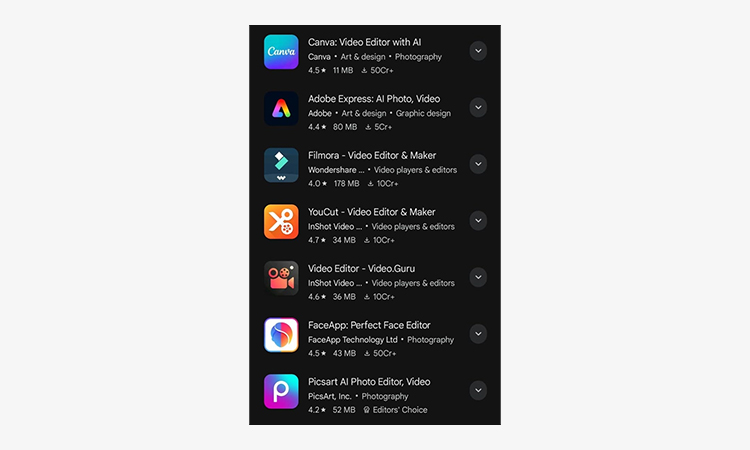
- Free programs like Windows Movie Maker and iMovie (Mac) offer basic editing capabilities for novices. These tools help you cut footage, add music, and create simple transitions.
- Canva also provides simple video editing with real estate-themed templates.
- Adobe Premiere Pro or Final Cut Pro are frequently used by professional agents for their sophisticated editing features. These programs provide improved special effects, audio mixing, and colour correction.
- DaVinci and Filmora can provide professional features for free, making them popular among budget-conscious agents.
- Mobile apps such as CapCut and InShot are excellent for short social media videos. You can use them to make short videos for Instagram and TikTok.
Step-by-Step Guide to Editing Videos on InShot
Optimizing videos for mobile devices is crucial for viewability across platforms. Your videos have to be mobile-friendly, as many of your clients search for services on their mobile devices. So you can use inShot on mobile to edit your real estate videos.
Step 1: Download and Open the App
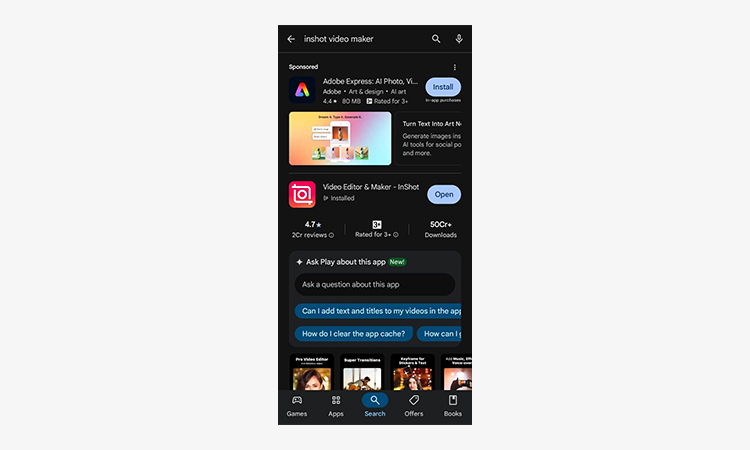
- First, you need to go to the Google Play Store or the Apple App Store.
- Search for “InShot” and install the app.
- Open the app once installed.
Step 2: Start a New Video Project
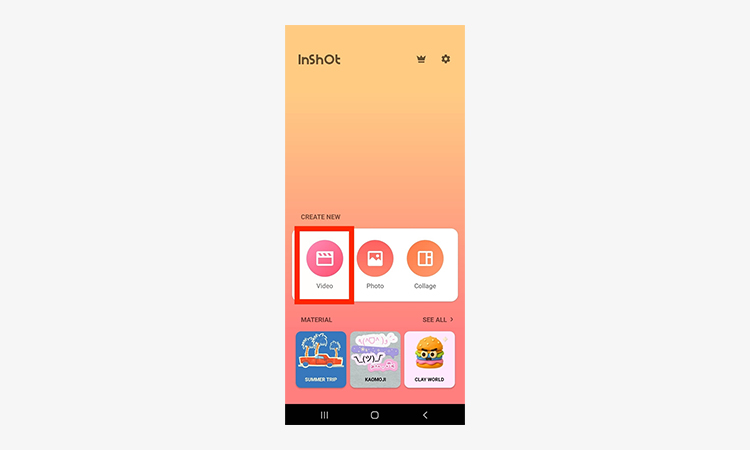
- Then you click on the “Video” option from the home screen.
- For each video you want to edit, tap “New” and pick it from your gallery.
- Select the green checkmark ✅ to import them.
Step 3: Trim or Cut Your Clips
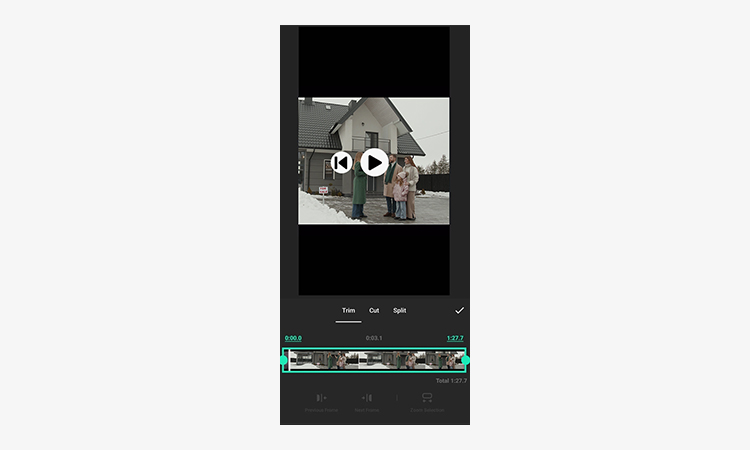
- You can cut out parts of the beginning or end of the video that you don’t want to see by using the Trim tool.
- Then, you can split a clip into two parts with Split. This will help you get rid of the middle part.
- Drag the ends of the clip bar in the timeline to reduce the clip quickly.
Step 4: Add Music or Voiceover
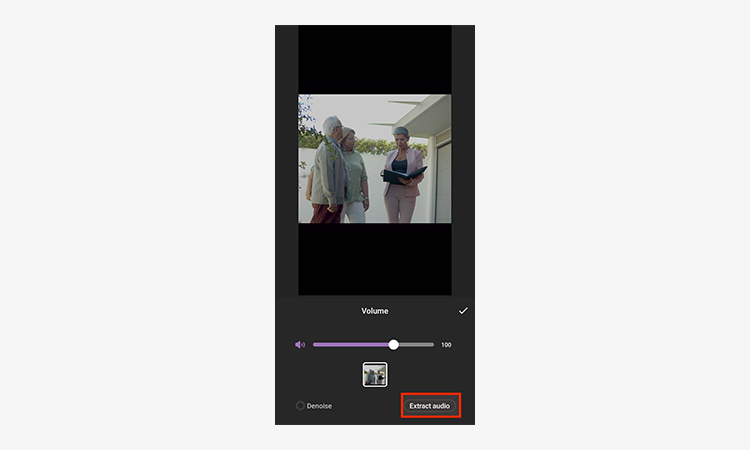
- You can find music at the bottom of the screen.
- Then you may choose from InShot’s free music or extract your audio.
- Or select “My Music” to add your audio.
- To add your sound, press “Record.” This is great for describing things about a place.
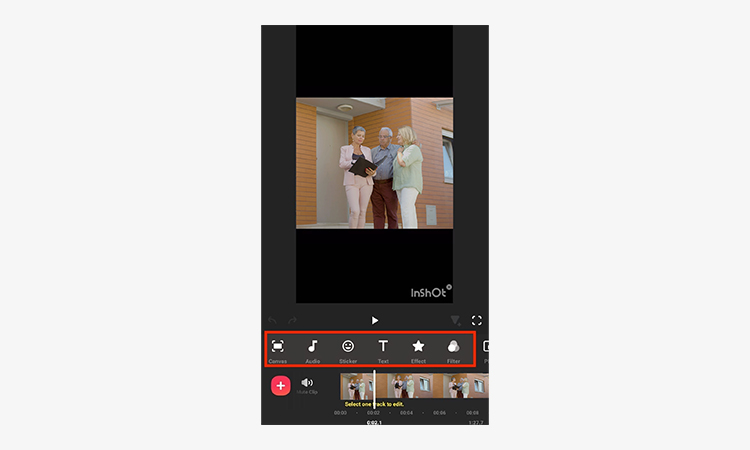
Step 5: Add Text and Titles
- Tap Text (T).
- Type your message, like “3 BHK in Downtown” or “Contact: 123-456-7890.”
- You can choose the font, colour, size, and animation style for your text.
- Drag and adjust the timing bar so the text appears at the right moment.
Step 6: Add Transitions Between Clips
- Tap on the white box between two clips.
- Select a transition effect (like fade, zoom, etc.) to make your video smoother.
- Adjust the speed and style of the transition.
Step 7: Add Filters and Effects
- Tap on Filter to change the look of your video.
- Use Adjust to manually fix brightness, contrast, or saturation.
- Tap Effects to add motion, zoom, or light effects (use sparingly for professional videos).
Step 8: Adjust Video Size and Format
- Tap Canvas to choose your video size:
- 16:9 for YouTube.
- 1:1 for Instagram posts.
- 9:16 for Instagram Reels, TikTok, or YouTube Shorts.
- You can move or zoom your clip to fit perfectly in the frame.
Step 9: Add Logo or Watermark
- Get your brand logo by tapping “Sticker” and then selecting “Image.”
- Put it in the corner.
- You can change its size and make it show up at the beginning or throughout the whole video.
Step 10: Save and Export the Video
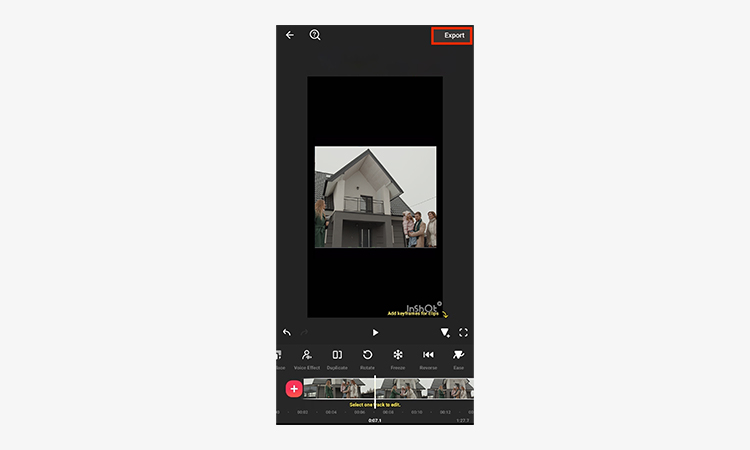
- Tap the arrow in the top right corner.
- Choose video quality: 1080p (recommended) or 720p.
- Then you can tap “Export”. Your video will be exported and saved to your gallery.
Extra Tips:
- Keep videos under 3 minutes for better engagement.
- Use the “Preview” option often to check your edits.
- Select matching background music that suits your property’s mood (calm, modern, etc.).
- Your contact information and branding should always be prominent.
Optimise for Search
You need to use relevant keywords to spread your videos. You can use Ubersuggest (by Neil Patel), Google Keyword Planner, AnswerThePublic, Google Trends, YouTube Search Autocomplete, VidIQ (YouTube Chrome Extension), TubeBuddy (YouTube Chrome Extension), and Soovle.
Do you know what will be the best tips for you?
You can use 2-3 tools to get the optimum results-
- Like, you can use Google Trends to spot rising topics
- Then use Ubersuggest or AnswerThePublic to build keyword lists
- Moreover, utilize tools like TubeBuddy or VidIQ to check what’s working on YouTube
- Utilize the Soovle keyword research tool
You can go to https://soovle.com and write your main keyword to search for other related terms. You can get keywords that are used in up to 10 search engines like YouTube, Yahoo, and so on.
- Use YouTube Auto-Suggest (Free Tool)
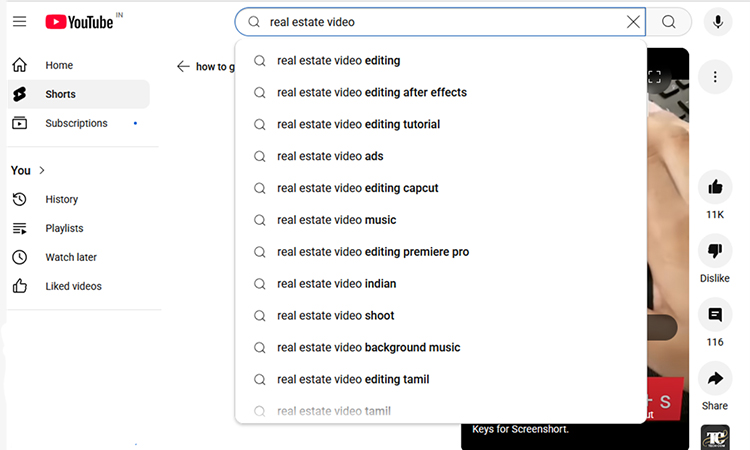
- Go to YouTube.com.
- In the search bar, type your topic, like: real estate video
You’ll see suggested search terms like:- “Real Estate Video Ideas”
- “real estate video tour”
- “real estate video script”
- These are the actual keywords that your target audience uses to find specific services.
- Then you can create a list of these most searched keywords and input them into your video description.
- Use Google Auto-Suggest + People Also Ask
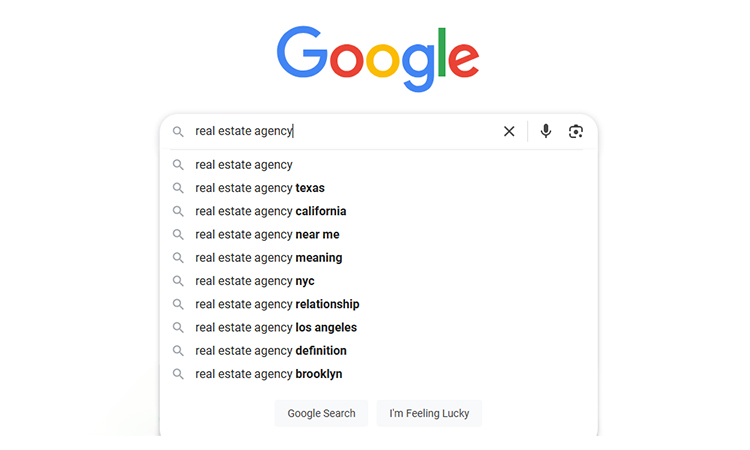
- Go to Google.com.
- Search for phrases like how to create a property video.
- Look at:
- Auto-suggestions while typing.
- People Also Ask box.
- Related Searches at the bottom.
- These are the keywords that your actual audience searches for. And you need to optimize these in your content appropriately.
- Ubersuggest Gives You A Bunch Of Keywords
Log in to the https://neilpatel.com/ubersuggest account
Then, see the left side of the column and click “Keyword research” -> write your main keyword -> search
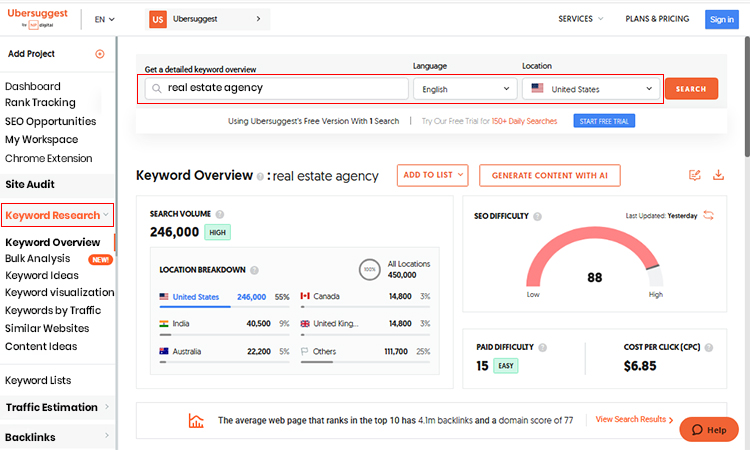
Then you will have the list of keywords. You have to choose keywords by Search volume and SEO difficulty.
- 0–20: Easy (Low competition, new creators can rank)
- 21–40: Moderate (Need good content and optimization)
- 41–60: Hard (Top content + backlinks needed)
- 61–100: Very Hard (Competitive market, big brands dominate)
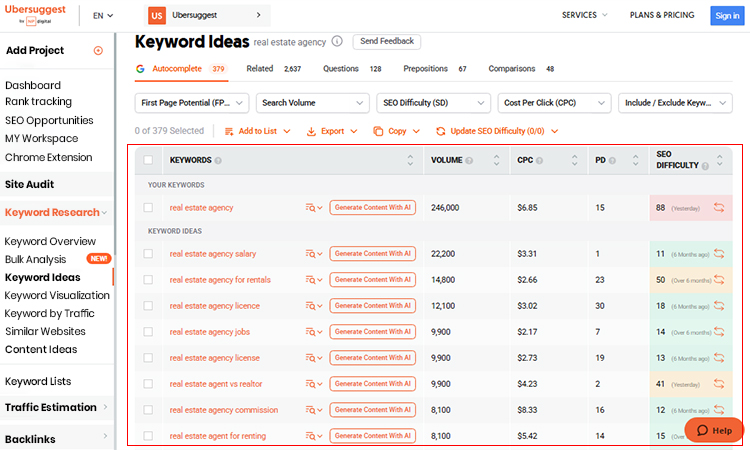
SEO difficulty– It indicates how challenging it is to rank your website or video for a keyword on YouTube or Google.
Search Volume: The number of monthly searches for that term on Google or YouTube.
- Higher volume = more potential viewers.
CPC (Cost Per Click): The amount that advertisers are prepared to spend for each click on that keyword’s advertisement.
- High CPC = important keyword with buyer intent.
| CPC Value | Meaning | Example |
| $0–$0.50 | Informational, low buying intent | “What is video marketing?” |
| $0.50–$2 | Moderate buying potential | “Best video editor for YouTube” |
| $2+ | High buying intent | “Hire a video editor for business” |
PD (Paid Difficulty): The level of competition for that keyword in paid ads (0 to 100). PD indicates the overall value of the keyword, but is more significant if you’re running video ads (Google Ads, YouTube Ads).
- High PD = many people are paying to rank for it.
| PD Score | Competition Level |
| 0–30 | Low – easier to compete organically |
| 31–60 | Medium – moderate competition |
| 61–100 | High – hard to compete (big brands) |
Final Tips
- Don’t chase only high volume — focus on intent + balance.
- For YouTube videos, long-tail keywords work best:
“How to create real estate video for beginners” - Use your main keyword in title, tags, description, and say it in your video (for captions & SEO).
- You may apply location-specific keywords to make your listing videos easier to find.
- Your thumbnails should be well-designed. So that you can attract more buyers and increase engagement.
- Share videos on a lot of different platforms to get the most views and comments.
Build Consistency
You have to post frequently and update old content with new trends. Most realtors forget to update their old videos with their recent work. Creating personalized video responses can help build stronger connections with clients. Moreover, you can set a schedule that you can maintain long-term. Quality matters more than quantity, but consistency builds audience trust. Network with other professionals who can share your content and expand your reach.
Which Types of Real Estate Videos Work Best?
The best real estate videos blend entertainment and education to show off your knowledge and available properties. So that your buyers can make well-informed decisions.
- Virtual Home Tours- You can create engaging walkthroughs that help your buyers to explore homes from anywhere. Virtual home tours have become more accessible for real estate professionals due to advancements in technology. Then you can showcase each room to the audience, including important details like modern kitchens or roomy bedrooms. This strategy helps buyers choose between options before they go see them in person.
- Neighborhood Guide Videos- One effective approach is showcasing the local area. You can create videos highlighting nearby schools, parks, shopping centers, and restaurants. Aerial videos can provide stunning views of properties and their surroundings, enhancing real estate presentations. Prospective buyers are interested in more than just the property itself. They want to know about the neighborhood as well. Drone videos offer high-quality aerial footage that captures property landscapes and overall scale.
- Before and After Transformations- Moreover, you can record video of remodeling tasks or transformations in progress. Time-lapse videos effectively show the development or transformation of a property over time. These engaging videos illustrate the potential of homes and help buyers envision avenues. This strategy works particularly well for fixer-uppers or updated properties.
- Client Success Stories—You have to show testimonial videos to prove the success of your methods and attract more clients. These videos attract various clients. They can see the potential of their dream homes and envision the possibilities for renovation. When you show your clients experience, it demonstrates your credibility.
- Market Update Videos— Furthermore, one key strategy is providing regular market insights. You may compose short films to talk about what’s new, how prices have changed, and what buyers should know. This makes you the local expert and keeps your name in people’s minds.
- Quick Tips and Advice: You can take complex real estate topics and break them into simple, engaging content. In addition, your videos should consist of home buying, inspections, and financing. These instructional videos teach you what your audience values most.
- Live Virtual Open Houses—You should allow viewers to ask questions during live tours and receive prompt answers. This allows for a more interactive experience and helps build a stronger connection with your audience.
When Should You Post Real Estate Videos for Maximum Engagement?
You can consider the time slots to get the most attention from your target audience-
- Tuesday through Thursday: You can update between 10 AM and 2 PM when people browse during work breaks. However, you may avoid Mondays (too busy) and Fridays (weekend planning).
- Weekend Timing: Saturday mornings (9-11 AM) work well for home buyers who have time to watch property tours.
- Evening Hours: 6-8 PM on weekdays, catch people relaxing at home after work.
Platform-Specific Timing
- Facebook: 1-3 PM on weekdays
- Instagram: 11 AM-1 PM and 7-9 PM
- YouTube: 2-4 PM and 8-10 PM
- TikTok: 6-10 AM and 7-9 PM
The Real Psychology
You may think, why are these particular timings best because they match when people are:
- Mentally available (not stressed or rushed)
- Physically stationary (commuting, lunch breaks, home relaxing)
- Open to making decisions (not overwhelmed with other tasks)
Bottom Line: Success comes from posting when your audience is naturally browsing, not when it’s convenient for you to post.
Where Can You Distribute Your Real Estate Videos?
- Social Media Platforms- Social media is the most influential platform to gain new clients. So start with posting on Facebook, Instagram, TikTok, and YouTube to reach different audiences. Personalized video responses to leads help agents establish stronger connections with potential clients. Each platform has a distinct audience that prefers different video formats.
- Your Website- Then you need to place videos on property listings and your homepage. This keeps visitors on your site for longer and raises search rankings.
- Email Marketing- Moreover, you should incorporate video links in newsletters and property alerts. Videos in emails get 200-300% more clicks than text alone.
- MLS Listings- You can post videos directly to Multiple Listing Service (MLS) sites where buyers and other agents look for homes.
- Real Estate Portals- Put your ad on Zillow, Realtor.com , and other real estate websites where serious buyers look.
- Text Messages- Then you may provide video links to interested buyers. They will get a quick property tour via text, creating immediate engagement.
- Direct Mail- Moreover, you may implement QR codes on postcards that link to property videos. This links offline marketing to digital content.
Top 8 Most Useful Examples Of Video Marketing For Real Estate
1. Zillow
- Type: Marketplace platform
- Why it’s the best: It has high user engagement and uses immersive 3D tours and video descriptions integrated into listings.
- Returns: millions of users every month; video content improves conversions and time
2. Sotheby’s International Realty
- Type: Luxury real estate
- Why Best: Cinematic productions, high-quality drone videos—they focus on elite buyers.
- Luxury sales are up because of emotional appeal and visual storytelling.
3. Compass Real Estate
- Type: Tech-focused real estate firm
- Why it’s the best: It uses branded agent videos, testimonials, and social media updates about the market.
- Returns: quicker closings and a more powerful branding of the agent.
4. Redfin
- Type: Real estate brokerage
- Why Best: Produces useful educational content for buyers and sellers as well as videos of
- Returns: Higher trust and website conversion rates.
5. The Agency RE
- Type: Luxury real estate (Beverly Hills)
- Why Best: It implements reality-style walkthroughs and renovation stories.
- Returns: They get a strong following and widespread acceptance in luxury markets.
6. Douglas Elliman
- Type: Residential real estate
- Why Best: Agent stories, high-end listing videos, and Instagram Reels.
- Returns: Strong agent engagement and high-end property awareness.
7. eXp Realty
- Type: Cloud-based brokerage
- Why Best: Hosts virtual open houses and livestream tours.
- Returns: High engagement among remote buyers and global investors.
8. RE/MAX
- Type: Global real estate brand
- Why Best: Market update videos and education series across countries.
- Returns: Acquires authority and attracts repeat clients.
9. Berkshire Hathaway HomeServices
- Type: Real estate brokerage
- Why Best: They create educational video collections and agent marketing tools.
- Returns: Helps agents nurture leads better; strong conversion results.
10. Weichert Realtors
- Type: Full-service agency
- Why Best: They successfully recruited short-form video content for Instagram/Facebook ads.
- Returns: Local lead generation was enhanced by the performance of visual ads.
How to Track Your Real Estate Video Performance?
- Platform Analytics: First, you have to look at the stats that come with YouTube, Facebook, and Instagram. Check out the videos’ views, watch times, and rates of involvement to find the best ones.
- Website Tracking—To see how many times your videos have been watched, use Google Analytics. Keep track of how long people stay and if they get in touch with you after watching.
- Lead Generation Metrics: After sharing videos, keep track of the calls, emails, and requests to show them. This shows a real effect on business, not just views.
- Engagement Stats: You should keep an eye on the likes, comments, shares, and saves. When your reaction is high, it means that people think your content is useful and worth sharing.
- Conversion Tracking: Then you have to keep track of how many people who watch a movie end up buying something. This helps you to understand which video gets the most conversions and which ones are the most effective in generating sales.
What’s Next for Real Estate Video Marketing?
Technology will simplify the process of creating videos and enhance the interactive and customized viewing experience for every prospective customer.
- AI-Powered Video Creation- AI will automatically produce virtual staging, make property videos from photos, and create personalized tours based on the tastes of each prospective buyer.
- Interactive Virtual Reality- People can “walk through” houses with VR glasses from anywhere. They can open drawers, turn on lights, and feel things as if they were really there. It provides a realistic and immersive experience for potential buyers.
- Live Shopping Features- Social media platforms will add “buy now” buttons to property videos. As buyers watch tours, they can directly make offers or set up displays.
- Drone Technology Advances- Effortless, automatic property tours may be made with the use of indoor drones. With no human intervention, AI will plot out the most efficient routes through residential areas.
- Personalized Video Content- Smart systems will use each buyer’s search history to generate personalized videos that only display the rooms and features they are interested in.
- Voice-Activated Tours- The purchasers will manipulate video tours using voice commands, asking questions like “Show me the kitchen” or “What’s the square footage?”
Frequently Asked Questions
Yes, absolutely. Videos help buyers quickly grasp spaces because they flow better than photos and show room layouts. They draw in more qualified and genuinely interested leads. Additionally, videos help listings stand out online and receive more social media shares, which raises popularity and speeds up sales.
Basic Tours: $300-500 for quick videos that include music.
Premium Services: $800-1,500 for videos made with drone footage and expert editing.
Hourly Rates: 75 to 150 dollars per hour for editing and filming.
Package Deals: $200-400 for multiple properties recorded in one day. Price fluctuates depending on your location, experience level, and what services you include.
You can successfully build your real estate business by combining these four components.
Product: The homes and services you offer to buyers and sellers.
Price: Setting competitive listing prices and your commission rates.
Place: The neighborhoods and areas where you work and market properties.
Promotion: Your advertising, social media, videos, and marketing campaigns to attract clients.
Let’s Wrap Up
So, at the end of our guide, I can assume you will get all your answers about video marketing for real estate. You can develop a proper strategy to spread your video content through social media and other marketing platforms mentioned in this blog. But there is a suggestion that you may take help from a professional digital marketing agency so that your marketing process goes smoothly.
Yes, you may create your own real estate property videos and spread out online. But professional SEO experts do perfect keyword research, design a marketing strategy, and thumbnails for YouTube videos . These approaches can get the most return on investment and new leads.
So, implement this video marketing strategy in your advertising process and be a witness to a flourishing real estate brand.
Additional resources:
- SEO for Real Estate: A Step-by-Step Blueprint to Higher Rankings
- Top 33 Proven Ideas How to Generate Real Estate Leads

